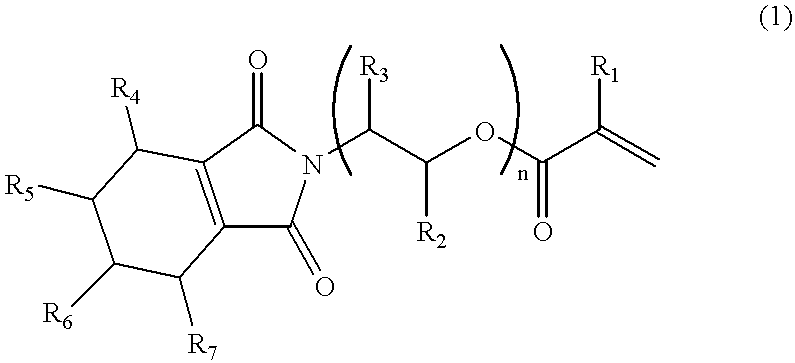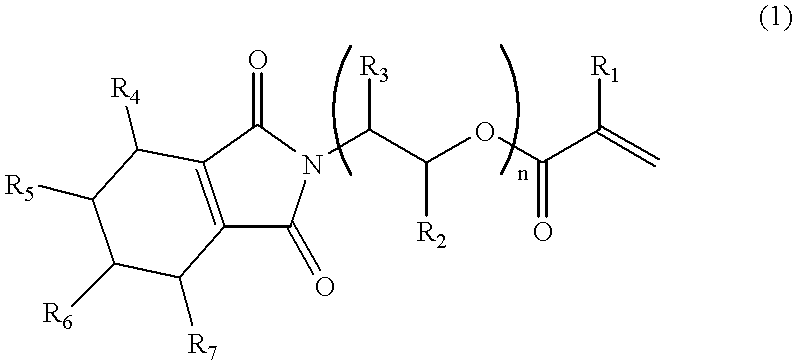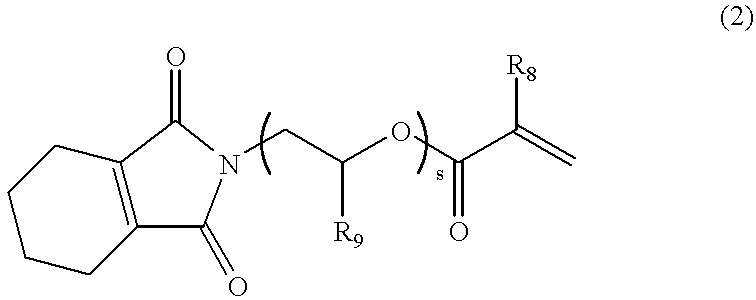Acrylates and actinic radiation-curable compositions containing them
a technology of actinic radiation and compositions, which is applied in the field of acrylates and actinic radiation cureable compositions containing them, can solve the problems of insufficient abrasion resistance and adhesiveness to plastics, weather resistance, and easy damage to the surface of the cured product, and achieves excellent adhesion to various plastics, reduces or abrasion resistance of the cured product, and high polarity
- Summary
- Abstract
- Description
- Claims
- Application Information
AI Technical Summary
Benefits of technology
Problems solved by technology
Method used
Image
Examples
example 1
152 Grams (1.0 mol) of 3,4,5,6-tetrahydrophthalic anhydride and 200 g of toluene were charged in a flask equipped with a stirrer, a condenser tube and a water separator (Dean Stark Trap) and heated to 50.degree. C. to dissolve the acid anhydride in toluene. Then, 61.1 g (1.0 mol) of 2-aminoethanol was added thereto dropwise over a period of 10 minutes, and thereafter the produced water was subjected to azeotropic dehydration with stirring at 120.degree. C. for 3 hours to remove 18 g of water.
After cooling to 40.degree. C., 79.3 g (1.1 mol) of acrylic acid, 0.12 g of hydroquinone monomethyl ether and 7.5 g of sulfuric acid were added to the flask, and the produced water was subjected to azeotropic dehydration with stirring at 120.degree. C. for 3 hours to remove 18 g of water.
After cooling, 200 g of a 10% aqueous NaOH solution was added to the reaction mixture, followed by stirring for 30 minutes. Thereafter, the reaction mixture was transferred to a separating funnel, and the aqueou...
example 2
The reaction and the after-treatment were carried out in the same manner as in Example 1, except that ethanolamine in Example 1 was changed to 75.1 g (1.0 mol) of 1-amino-2-propanol, thereby obtaining 220 g of a compound represented by the following formula. Viscosity of the compound was 1040 mPas / 25.degree. C.
The compound was a compound of the formula (2) in which R.sub.8 was H and R.sub.9 was CH.sub.3, and s=1, and this compound is called A-2. Data of identification of A-2 are shown below. ##STR5##
A-2 (light yellow liquid, viscosity 1040 mPas / 25.degree. C., refractive index 1.511, specific gravity 1.171).
.sup.1 H-NMR (270 MHz, CDCl.sub.3) .delta. 1.25(3H, --CH.sub.3, d), 1.70-1.95(4H, --CH.sub.2 --CH.sub.2 --CH.sub.2 --CH.sub.2 --, m), 2.25-2.45(4H, --CH.sub.2 --CH.sub.2 --CH.sub.2 --CH.sub.2 --, m), 3.70(2H, --N--CH.sub.2 --, m), 5.15(H, --CO.sub.2 --CH--, m), 5.85(1H, CH.sub.2.dbd.CH--, d), 6.10(1H, CH.sub.2.dbd.CH--, dd), 6.40(1H, CH.sub.2.dbd.CH--, d); .sup.13 C-NMR (67.8 MHz,...
example 3
The reaction and the after-treatment were carried out in the same manner as in Example 1, except that ethanolamine in Example 1 was changed to 105.1 g (1.0 mol) of 2-(2-aminoethoxy)ethanol, thereby obtaining 230 g of a compound represented by the following formula. Viscosity of the compound was 246 mPas / 25.degree. C.
The compound was a compound of the formula (2) in which R.sub.8 and R.sub.9 were H, and s=2, and this compound is called A-3. Data of identification of A-3 are shown below. ##STR6##
A-3 (light yellow liquid, viscosity 370 mPas / 25.degree. C., refractive index 1.511, specific gravity 1.190).
.sup.1 H-NMR (270 MHz, CDCl.sub.3) .delta. 1.70-1.95(4H, --CH.sub.2 --CH.sub.2 --CH.sub.2 --CH.sub.2 --, m), 2.25-2.40(4H, --CH.sub.2 --CH.sub.2 --CH.sub.2 --CH.sub.2 --, m), 3.70(6H, --N--CH.sub.2, --OCH.sub.2 --CH.sub.2 --O--, m), 4.15(2H, --CO.sub.2 --CH.sub.2 --, m), 5.85(1H, CH.sub.2.dbd.CH--, d), 6.15(1H, CH.sub.2.dbd.CH--, dd), 6.45(1H, CH.sub.2.dbd.CH--, d); .sup.13 C-NMR (67.8 M...
PUM
| Property | Measurement | Unit |
|---|---|---|
| Percent by mass | aaaaa | aaaaa |
| Percent by mass | aaaaa | aaaaa |
| Molar density | aaaaa | aaaaa |
Abstract
Description
Claims
Application Information
 Login to View More
Login to View More - R&D
- Intellectual Property
- Life Sciences
- Materials
- Tech Scout
- Unparalleled Data Quality
- Higher Quality Content
- 60% Fewer Hallucinations
Browse by: Latest US Patents, China's latest patents, Technical Efficacy Thesaurus, Application Domain, Technology Topic, Popular Technical Reports.
© 2025 PatSnap. All rights reserved.Legal|Privacy policy|Modern Slavery Act Transparency Statement|Sitemap|About US| Contact US: help@patsnap.com



